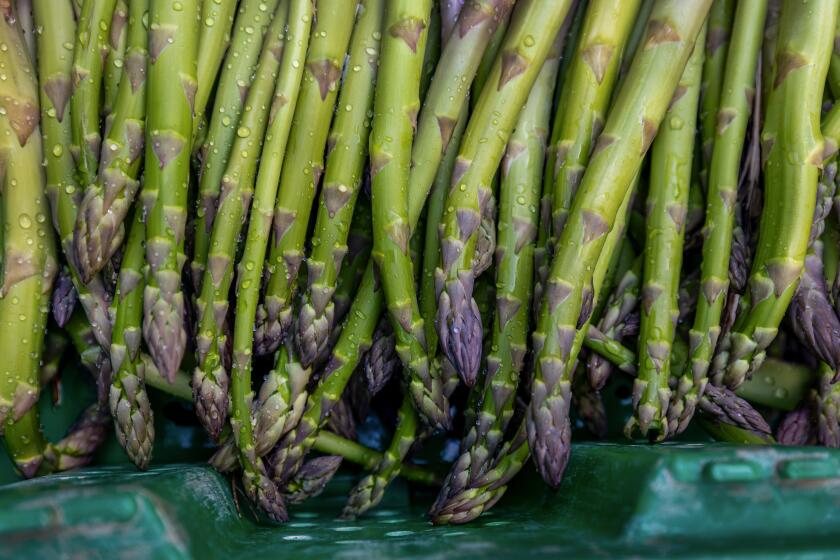
- Share via
- This month’s Mountain fire devastated avocado orchards in Ventura County, which is now the largest avocado producer in California.
- Sergio Acevedo came to the U.S. with almost nothing and built up a farm of avocados and other crops over two decades.
- The fire ripped through his farm, taking a third of his trees. Here’s how he hopes to rebuild.
SOMIS — Thousands of Hass avocados littered the soil in Sergio Acevedo’s orchard Saturday in this community northeast of Camarillo. The Mountain fire had scorched some of the fruit, leaving it shriveled or in ashes.
But the ferocious winds that followed the blaze ripped through the area and tore more than half of the remaining avocados off the trees, scattering them across his two-acre farm. Most of the fruit on the ground appeared untouched — bright green and good enough to eat.
But Acevedo knew better. He picked one off the ground and cut off a slice to reveal the inside: dry and dull green.

“You see? There’s no oil. It’s not ready,” he told his daughter Wendy Acevedo. “But it was so close.”
The avocados were only about a month away from being ripe enough for market. The 75-year-old shook his head and chucked the ruined fruit back on the ground. Over the weekend, Acevedo and his family surveyed their land, where the fire had damaged or destroyed an estimated 100 of his 300 avocado trees. Acevedo’s orchard is one of more than 140 avocado farms in the burn area, according to Ventura County Agricultural Commissioner Korinne Bell.
The county is the state’s top producer of avocados, she said.
Most of the avocado producers in the Mountain fire burn area are small-scale farmers, Bell said: “They have a small couple [of] acres here or there.”
As of last week, the Mountain fire had burned 12,000 acres of agricultural land. Avocados were among the crops hit hardest.

So far, 4,102 acres of avocados were in the burn area, representing a quarter of the 16,497 acres of avocados harvested in Ventura County last year. However, it’s too soon to know exactly how many avocado trees in the area sustained damage or were destroyed, Bell said.
County officials have completed a quarter of their survey and counted 588 avocado acres that were damaged or destroyed during the fire. Losses are estimated at $4.3 million.
“We expect that number to go up a lot,” Bell said.
At the turn of the 21st century, California growers were farming more than 36,000 acres of asparagus. Now, fewer than 3,000 acres are in production in the state for commercial sale. These are the last three farms.
It’s not clear yet whether the avocado market will be affected by the fire, because most of the harvest starts in winter and goes into summer in Ventura County, she said. “So if there are market impacts we will not see them until then.”
For now, consumers are unlikely to see a surge in the price of avocados from the fire because most avocados bought in the U.S. are imported from Mexico.
In total, more than 240 structures, many of them primary residences, have been destroyed and 127 damaged during the Mountain fire. As of Wednesday, the nearly 20,000-acre fire was 98% contained.
Current harvest nearly wiped out

Acevedo said he felt badly for the many who lost their homes in the fire. He lives in Oxnard with his wife and never built a home on his farm. But it pained him to see how the fire had torched the trees he’d so lovingly tended for nearly 25 years.
The blaze also destroyed his irrigation system. He didn’t have fire insurance, he said.
In the first few days after the fire, Acevedo said, he was devastated by the images he saw of destruction. But a few days later, he switched to focusing on moving forward. Wendy, 43, started a GoFundMe for him. At first, her father was against it. He’s still a bit hesitant.
“You’re always helping other people. It’s time for you to accept help too,” she told him as they walked through the damaged orchard.
He’s reminded himself of his beginnings as an immigrant farmer who came to the United States and started with nearly nothing. He had only $100 in his pocket when he left Mexico City for the U.S. in the 1970s, he said. From that, he bought a home, put his two children through college and put a down payment on his daughter’s home.
In 2003, Acevedo poured most of his retirement money into buying the avocado orchard where he also grows a smattering of other fruit such as mandarins, cherimoya and pomegranates. After years of him spending every free minute on the farm, his orchard became productive and profitable enough to sustain itself.

The farm wasn’t just an investment, it became his refuge.
It was the setting for so many family memories, life landmarks and new traditions. It‘s where he taught his son, now an adult, how to drive. It was where his daughter married 16 years ago, between mandarin and orange trees he’d just planted. And it’s the place where his granddaughters plant pumpkin seeds in the spring and pick pumpkins in the fall.
During the week, he works as a diesel mechanic for an agricultural company and spends most of the weekend on the orchard. He’d hoped to retire on the farm, but that seems like a tougher proposition now.
“Nothing is impossible,” he said. “You just have to work hard. I just need to start over.”
The family behind Koda Farms rice licensed its trademarks to Western Foods. But the family is not selling their land in South Dos Palos.
He said he tries to see the fire as a setback but not the end. It takes an avocado sapling three years to begin producing fruit and about five years to provide a full yield. Acevedo will have to wait until February to grow his next saplings — all of them Hass, the major variety grown in California.
But first he’ll have to prepare the land, including cutting the dead trees down to the stump, removing the roots and having it all removed from his property. It will take at least $20,000 just to do that, and that’s not accounting for his nearly entire loss of this year’s harvest, he said.
Acevedo said he probably will be in the red for a few years before breaking even. Wendy said she’s helped her father apply for financial assistance with the U.S. Department of Agriculture.

On Saturday, Acevedo, a spry and agile senior, moved quickly to inspect the orchard. Several trees were completely charred. Some had fallen over. Others looked parched but had a few avocados barely hanging on. Then there were a bunch of vibrant green trees — spared from the inferno.
He approached a navel orange tree that had some scorched branches. He picked up a recently fallen orange and took a knife from his pocket to slice it in half. Acevedo peeled off some of the skin and took a big bite.
“It’s still sweet,” he said. “This tree, this one, will be fine.”
More to Read
Eat your way across L.A.
Get our weekly Tasting Notes newsletter for reviews, news and more.
You may occasionally receive promotional content from the Los Angeles Times.














